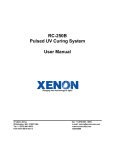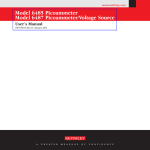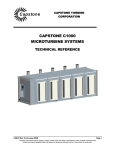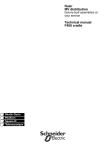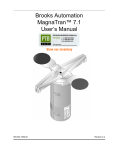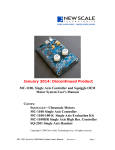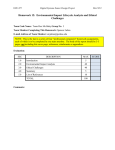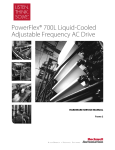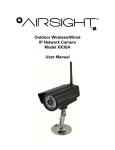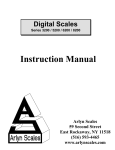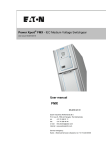Download RC-742 Pulsed UV System Installation
Transcript
XENON CORPORATION RC-742 Pulsed UV System Installation & Maintenance Manual RC-742 Pulsed UV System Installation & Maintenance Manual Bringing new technology to light! 37 Upton Drive Wilmington, MA 01887 USA (978) 661-9033 Part # 810-0057; Rev E fax: (978) 661-9055 e-mail: [email protected] www.xenoncorp.com 3/9/06 i XENON CORPORATION RC-742 Pulsed UV System User Manual RC-742 Pulsed UV System Installation & Maintenance Manual Return and Warranty Information Company Name_____________________________________________________________ Equipment Description________________________________________________________ Equipment Location_____________________________ Equipment #__________________ PFN Serial #__________________________________ HVPS Serial #_________________ Housing Serial #________________________________ Date Installed_________________ Lamp 1 Serial #________________________________ Date Installed_________________ Lamp 1 Part #_________________________________ Length of Service______________ Lamp 2 Serial #________________________________ Date Installed_________________ Lamp 2 Part #_________________________________ Length of Service______________ Lamp 3 Serial #________________________________ Date Installed_________________ Lamp 3 Part #_________________________________ Length of Service______________ Lamp 4 Serial #________________________________ Date Installed_________________ Lamp 4 Part #_________________________________ Length of Service______________ Bringing new technology to light! 37 Upton Drive Wilmington, MA 01887 USA (978) 661-9033 fax: (978) 661-9055 e-mail: [email protected] www.xenoncorp.com Part # 810-0057; Rev E 11/28/06 ii XENON CORPORATION RC-742 Pulsed UV System User Manual 1. General Information 1-2 1.1 About This Installation & Maintenance Manual 1.2 Symbols Used 1.3 Warranty 1.3.1 Statement 1.3.2 Return Return Procedure 1.4 Getting Help 1.4.1 Xenon Web Site 1.4.2 Correspondence 1.4.3 Telephone Numbers 1-2 1-2 1-2 1-2 1-3 1-3 1-3 1-4 1-Error! Bookmark not defined. 2. Product Safety Information 2-2 2.1 Rupture Precautions 2.1.1 Preventing Rupture 2.1.3 Handling Breakage 2.2 High Voltage and Electrostatic Discharge Precautions 2.3 UV/VIS Light Precautions and Filtering 2.4 Ozone Precautions and Venting 2.5 Mounting and Interconnection Stability Precautions 3. Installation and Operation 3-1 3.1 Introduction 3.2 System Components 3.2.1 PFN Control Module 3.2.2 High Voltage Power Supply 3.2.3 Lamp Module 3.3 Options 3.4 Tools and Equipment 3.5 Environmental Specifications 3.5.1 Cooling Requirements 3.5.2 Utility Requirements 3.5.3 Control Interface 3.6 Unpacking and Initial Inspection 3.6.1 Components Included 3.6.2 Unpacking the System 3.7 System Installation 3.8 System Operation 3.8.1 Continuous and Cycled Modes 3.8.2 Power-up and Cure 3.8.3 Faults and System Power-down 3-1 3-1 3-1 3-2 3-2 3-3 3-4 3-4 3-4 3-4 3-6 3-12 3-12 3-12 3-12 3-13 3-14 3-14 3-14 4. Maintaining the System 4.1 4.2 4.3 4.4 4.5 2-2 2-2 2-1 2-2 2-4 2-5 2-6 4-1 Cooling Vents Lamp Housing and Flash Lamp Troubleshooting Repair Specifications and Drawings 4-1 4-1 4-1 4-1 4-3 5. Field Bulletins 5-1 5.1 Rapid ON-OFF cycling of the high voltage (Bulletin No. 989-0022) Part # 810-0057; Rev E 11/28/06 iii 5-1 XENON CORPORATION RC-742 Pulsed UV System Installation & Maintenance Manual 1. General Information 1.1 About This Installation & Maintenance Manual In addition to general company, product and safety information, this manual provides an overview of the RC-742 product and specifications with instructions for application, installation, maintenance and replacement. See the appropriate lamp housing Installation & Maintenance manual for details on lamps and housings. Fill in the product identification page in this manual so that your equipment module serial numbers and pertinent data are recorded in case of problems or warranty claims. 1.2 Symbols Used Xenon is committed to its customers and the safe use of its products. Since high voltage, electrostatic discharge, ozone, and UV light can cause hazardous conditions, the following types of warning symbols are included in this manual. WARNING A WARNING message means that failure to follow directions could result in bodily harm or loss of life. CAUTION A CAUTION message means that failure to follow directions could result in damage to equipment or loss of operation. NOTE A NOTE gives important clarifying information or specific instructions. Part # 810-0057; Rev E 3/9/06 1-1 XENON CORPORATION 1.3 RC-742 Pulsed UV System Installation & Maintenance Manual Warranty 1.3.1 Warranty Statement XENON Corporation Warranty Seller warrants to the first purchaser (i) each System sold by it to be free from defects in materials and workmanship for a period of one (1) year from date of shipment from the factory; (ii) all Components sold by it to be free of defects in material and workmanship for a period of ninety (90) days from the date of shipment from the factory; and (iii) all Lamps sold by it to be free of defects in material and workmanship for a period of thirty (30) days from the date of shipment from the factory. Seller’s obligations under this warranty are limited to, at Seller’s option, repairing or replacing any Systems, Components or Lamps, which in the sole judgment of the Seller, are found to be defective and which are returned freight paid to Seller, provided that such return has been authorized by Seller. Consumable items are specifically excluded from this warranty. Consumable items include, but are not limited to, reflectors, fuses, filters, windows, gaskets, and seals. All warranty repair or replacement shall be limited to product failures which, in the sole opinion of Seller, are due or traceable to defects in original material or workmanship. This warranty does not extend to any of Seller’s Systems, Components or Lamps which fail to operate by reason of installation, application, or inspection, or have been subject to misuse, neglect, or accident, or have been repaired or altered outside of Seller’s factory. EXCEPT AS STATED ABOVE, SELLER DISCLAIMS ALL WARRANTIES, WHETHER EXPRESS OR IMPLIED, WRITTEN OR ORAL, WITH RESPECT TO THE PRODUCTS, INCLUDING BUT NOT LIMITED TO ANY WARRANTY OF MERCHANTABILITY OR FITNESS FOR A PARTICULAR PURPOSE OR ANY WARRANTY WITH RESPECT TO INFRINGEMENT OR ALLEGED INFRINGEMENT OF PATENTS, COPYRIGHTS, TRADEMARKS, TRADE SECRETS AND OTHER INTELLECTUAL PROPERTY OR PROPRIETARY RIGHTS BY THE PRODUCTS. SELLER’S MAXIMUM LIABILITY ARISING OUT OF THE SALE OF THE PRODUCTS OR THEIR USE, WHETHER BASED UPON WARRANTY, CONTRACT, TORT OR OTHERWISE, SHALL NOT EXCEED THE ACTUAL PAYMENTS RECEIVED BY SELLER IN CONNECTION THEREWITH. IN NO EVENT SHALL SELLER BE LIABLE FOR INDIRECT, SPECIAL, INCIDENTAL OR CONSEQUENTIAL DAMAGES, INCLUDING, BUT NOT LIMITED TO, LOSS OF PROFITS, LOSS OF DATA OR LOSS OF USE DAMAGES, ARISING HEREUNDER OR FROM THE SALE OF THE PRODUCTS, REGARDLESS OF ANY KNOWLEDGE OF SELLER OF SUCH POTENTIAL DAMAGES. THE FOREGOING INDEMNIFICATION PROVISIONS STATE SELLER’S ENTIRE LIABILITY. 3/31/05 Part # 810-0057; Rev E 3/9/06 1-2 XENON CORPORATION RC-742 Pulsed UV System Installation & Maintenance Manual 1.3.2 Warranty Return Procedure Use the following procedure for warranty returns. 1. Call Xenon Customer Service, +1-978-661-9033 between 9:00 a.m. and 4:00 p.m. EST. Before placing your call have available Product model and serial number(s) A list of all options installed on your product A detailed description of the problem. 2. Xenon will provide an RMA (Returned Material Authorization) number. The RMA number is required before any product can be returned to Xenon. Insure that the RMA number appears on all shipping documents and on the outside of the shipping container. An RMA number must be established prior to returning any materials to Xenon 3. Remove all features, parts, options, alterations, and attachments not under warranty service before returning the product. Xenon is not liable for any loss of or damage to these items. 4. Arrange for a courier to pick up your product and return it to Xenon for repair via a prepaid common carrier. Pack the system well to avoid any additional damage. Xenon recommends using the original packing materials. Clearly mark the RMA number on the shipping label. 5. Xenon will attempt to repair the product within a reasonable time after receipt. Once repaired, Xenon will return the product via your choice of carrier. Shipping costs are the customer’s responsibility. 6. If Xenon determines the damage is not covered by the warranty, you will be contacted to determine if you want Xenon to repair the damage for a charge or whether the product should be returned to you not repaired. 1.4 Getting Help If you have a problem that is not covered by the information in this manual, seek help from the following additional sources. 1.4.1 Xenon Web Site The Xenon Web Site has information on this product as well as related systems and the latest technical and application notes. Access the Xenon Web Site by logging on to the Internet at http://www.xenoncorp.com. Part # 810-0057; Rev E 3/9/06 1-3 XENON CORPORATION RC-742 Pulsed UV System Installation & Maintenance Manual 1.4.2 Correspondence To contact Xenon write or e-mail directly to Xenon Corporation c/o Customer Service Department 37 Upton Drive Wilmington, MA 01887 USA [email protected] 1.4.3 Telephone Numbers Voice Fax Part # 810-0057; Rev E — 978-661-9033 — 978-384-6219 3/9/06 1-4 XENON CORPORATION 2. RC-742 Pulsed UV System Installation & Maintenance Manual Product Safety Information This equipment is designed for integration into larger-scale processing systems by skilled, technically competent Original Equipment Manufacturers (OEMs). Properly trained personnel must perform module installation and integration. Read this manual for a complete understanding of the system before servicing the equipment. Products within the lamp housing and produced by the lamp are only harmful when misunderstood or mishandled. The icons included in this section may be located on equipment or in areas where hazardous conditions exist. Although the modules have warning labels, a thorough understanding of the dangers involved is essential for safety. Caution, along with a general understanding of any device or chemical hazards, reduces the possibility of injury or damage to equipment. 2.1 Rupture Precautions 2.1.1 Preventing Rupture Generally, Xenon lamps have near atmospheric pressure making them easy to handle without the rupture concern that characterizes high-pressure xenon (CDC) lamps. In operation, however, rapid ionization of gas molecules expanding throughout the lamp structure generates significant shock waves. Such gas expansions can cause rupture if the surface of the lamp envelope has been marred or weakened from improper handling or use. To minimize rupture likelihood, use the following precautions when handling flash lamps: • Use only Xenon Corporation flash lamps because each design is customized to user system parameters. • Transport the lamp in a protective cover or case and never drop or bump the lamp. • Always wear clean, cotton lint-free gloves when handling the lamp. • When installing the lamp, avoid scratching the envelope surface on sharp metal objects. • Always wear eye protection in case of rupture. • Always use the lamp in a contained housing if the Xenon housing recommendation is not suitable for the application. • The lamp housing is designed for cooling criteria of: Air volume: 300 cfm (cubic feet per minute) Static pressure: 2.0” of H20 Direction of flow: in air inlet; out light blocking filter • Always use an air flow system to effectively remove heat from the lamp housing. Proper airflow also enhances lamp performance. For other than the design application, consult Xenon or Technical Note No. 986-0025 for recommended cooling requirements. • NEVER operate the system in a flammable or explosive atmosphere. 2.1.3 Handling Breakage In case of a rupture of the lamp envelope, follow the steps below: Part # 810-0057; Rev E 3/9/06 2-1 XENON CORPORATION RC-742 Pulsed UV System Installation & Maintenance Manual 1. Wear protective gloves and goggles. 2. Although the internal materials are not hazardous, minute glass slivers from a rupture can cause injury. Take precautions to avoid cuts or scratches. 3. Use a vacuum to collect glass particles. If such a device is not available, Xenon recommends return of the system for proper cleaning. 4. With all glass removed gently wipe the optics with lens wipes, slightly dampened with optical cleaner. 5. Return used or spent lamps to Xenon Corporation, including ALL pieces of glass from any rupture. 6. Record all requested warranty/return receipt information packaged with each housing. All system information is helpful in determining if the lamp housing needs more extensive service. 7. Call Xenon to request a Return Number (RN) authorization and follow the return policy in Section 1. 2.2 High Voltage and Electrostatic Discharge Precautions WARNING Equipment marked with this symbol contains high voltage electrical hazards, multiple sources of power and/or electrostatic discharge potential. Lamp housings, lamp housing high voltage cables, power supplies or control modules typically have this label. 1. High voltage power levels are present in these modules that can cause severe injury or death. Use extreme caution when servicing this equipment. Enclosed areas have no operator-serviceable parts. To reduce risk of injury from electrical shock hazards, do not open enclosed areas unless instructed otherwise. 2. Although safety features have been incorporated into the equipment, they should not be considered absolutely fail-safe. Never defeat safety circuits. Part # 810-0057; Rev E 3/9/06 2-2 XENON CORPORATION WARNING RC-742 Pulsed UV System Installation & Maintenance Manual To reduce risk of injury from electrical shock, connect all modules to an earth ground. Power supplies or control modules marked with this symbol mean that an electrical ground connection is provided at that point. 3. The system contains safety ground connections (10 AWG green or green/yellow wires) that interconnect each module to earth ground. NEVER disconnect, alter or remove these connections. NEVER use an outlet adapter that will isolate the unit from earth ground. CAUTION Electrostatic discharge can damage equipment. Make sure all components are grounded. 4. Take electrostatic discharge precautions. Wear electrostatic wristbands. To avoid damage to components, touch a grounded surface before touching any component. 5. Before servicing, disconnect the main (220 VAC) power source supplying all modules. 6. With the system de-energized, use a high voltage (10KV) meter to test for the presence of voltage on the high voltage capacitors in the power supply to make sure the discharge circuits are operating properly. 7. Always test for the presence of voltage before installing safety jumpers across the high voltage capacitors. 8. NEVER attempt to discharge the high voltage capacitors by using a direct short across the terminals. If the discharge circuits are inoperative and the high voltage capacitors are charged, use a shorting-bar with built-in resistor connected to earth ground to discharge components storing dangerous electrical power. Only as a last resort, use a direct short to earth ground. Part # 810-0057; Rev E 3/9/06 2-3 XENON CORPORATION 2.3 RC-742 Pulsed UV System Installation & Maintenance Manual UV/VIS Light Precautions and Filtering The following background information is important when personnel have exposure or visible access to UV light sources. UV wavelengths between 320 and 380 nanometers (billionths of a meter) can cause photochemical damage to organic materials such as fading or darkening and structural damage from the breakdown of molecular bonds. Ultraviolet light at a wavelength of 300 nm can be 200 times more damaging than visible light of 500 nm. Flash lamps produce UV light for illumination and/or photochemical reactions. Thus it is important to shield and/or filter UV light to protect personnel. Continuous exposure without adequate protection can cause eye damage and skin cancer. Follow the precautions below when personnel have exposure or visible access to UV light sources. 1. Be familiar with the radiation characteristics of the lamp being used. 2. Make sure the lamp is properly shielded in a closed housing. 3. Shield any UV source from water, outside moisture and any visible direct or reflected light. Use sheet metal or UV-rated plastic as shielding materials. 4. When it is necessary to have visible access to UV light sources in bonding and curing operations, construct safety viewing windows. Use products that provide both optical clarity and quality but also ensure UV protection. Viewing window properties should also include impact resistance, matte finish to reduce glare and coatings to resist abrasion and chemicals so the viewing area does not haze under frequent contact or repeated cleanings. Acrylite GP, Acrylite OP-2 and Acrylite OP-3 (CYRO Industries, 100 Enterprise Drive, Rockaway, New Jersey 07866, 1-800-631-5384, www.cyro.com) are recommended materials for safely viewing UV light sources. Consult the manufacturer for your particular application. 5. Avoid direct exposure to radiation, prolonged exposure to reflected light and UV leakage through cracks or from optics. Regardless of optical filtering, avoid directly viewing any UVproducing light sources. WARNING Prolonged exposure to UV light can lead to sunburn, skin cancer and eye damage. Wear protective clothing and UV light-blocking safety glasses. 6. When operating or in close proximity to UV light-producing equipment, always wear UV light-blocking safety glasses which can be purchased from Xenon Corporation. Part # 810-0057; Rev E 3/9/06 2-4 XENON CORPORATION RC-742 Pulsed UV System Installation & Maintenance Manual 7. NEVER look at the flash lamp directly. Use a filter and/or UV light blocking glasses at all times. WARNING Surfaces or equipment marked with this symbol mean the presence of a hot component or surface, typically the lamp housing. If this surface is touched, the potential for injury exists from generated heat. 8. Flash lamps also produce infrared energy, which means the housing, lamp, and reflector surfaces will normally exceed 50°C (122°F) during operation and can pose a burn hazard. Do not expose these areas to temperature-sensitive materials. Allow hot surfaces to cool at least five minutes before handling. 9. Do not open any cover, operate controls, make adjustments, or perform other procedures to an ultraviolet light source except those specified in this manual. 10. Allow only Xenon-authorized service personnel to repair the equipment. 2.4 Ozone Precautions and Venting Ozone is the combination of diatomic oxygen and monatomic oxygen. The gas is a strong oxidizer that over prolonged exposure decomposes organic compounds. Ozone has a bittersweet smell and is toxic in high concentrations. Exposure can cause headaches and dizziness. Ozone is also a natural form of oxygen and as such will revert back to oxygen within minutes. Thus there is no residual and potentially harmful chemical buildup over time. However, the U.S. Environmental Protection Agency provides a guideline of <0.08 PPM for safe levels of ozone in the workplace. 1. The cooling exhaust air from the lamp housings using Xenon quartz flash lamps produces ozone above the EPA standard. If the workplace is not vented to reduce the ozone level below the EPA standard, then the cooling air discharged from the lamp housing must be either removed or filtered through a charcoal filtering system. The Xenon germisil lamp does not produce ozone and therefore the cooling air exhausted from the lamp housing does not have to be removed or filtered. 2. Note that ozone levels will vary as temperature and humidity change. Use an ozone sensor to detect ozone and estimate ozone levels in parts-per-million. ECO Sensors, Inc., Model A20ZX (1-800-472-6626) or equivalent measures ozone and provides the data necessary to determine PPM ozone levels. Part # 810-0057; Rev E 3/9/06 2-5 XENON CORPORATION RC-742 Pulsed UV System Installation & Maintenance Manual 3. For further information on ozone in the workplace, order the ozone technical note from your Xenon sales representative. 2.5 Mounting and Interconnection Stability Precautions WARNING Personal injury or potential equipment damage can result from improper mounting or interconnection instability. 1. Read all warnings and cautions listed in the installation instructions. 2. The equipment allows for components to be mounted in any vertical or horizontal plane. Take precautions to provide for equipment stability and safety. 3. Ensure all modules are permanently attached to stable platforms. Each module must be level and non-moveable before operations begin. 4. To prevent instability, always install the heaviest modules below lighter components so the system is bottom-heavy. See the configuration drawing in Section 3 for module placement guidelines. Part # 810-0057; Rev E 3/9/06 2-6 XENON CORPORATION RC-742 Pulsed UV System Installation & Maintenance Manual 3. Installation and Operation 3.1 Introduction The RC-742 Pulsed UV System is a modular state-of-the-art light source designed to provide a broad spectrum of high-intensity pulsed light ranging from 200 to 1000 nanometers. The system is intended to function as part of an integrated larger-scale processing system with low voltage DC control circuitry options such as a Programmable Logic Controller (PLC), timer module, offline controller or adapter. Consult Xenon for option information. The system has been designed with the following features: • Modular components that provide flexibility and ease of integration • Full-featured optically isolated user interface for a computer or PLC • Continuous or cycled operation • Adjustable power range up to 2000 watts (System power is the product of lamp energy per pulse (Joules) x pulse rate (Hz). 3.2 System Components Three components make up the basic RC-742 system with interconnecting cables. They include: 3.2.1 PFN Control Module The Pulse Forming Network (PFN) and control module is made up of a capacitor C1 and inductor L1. Its function is to match the power supply to the flash lamp for optimum efficiency and performance. The PFN can accurately control flash lamp peak current, rise time and pulse width. By varying the values of C1 and L1, the RC-742 control module can accommodate many different applications. The safety discharge resistors R1 and R2 and the contact from relay K1 are connected to the PFN capacitor. This normally closed circuit acts as a ‘crowbar’ across the capacitor, safely discharging any hazardous energy whenever high voltage to the system is de-energized. The PFN Control Module controls the low voltage DC control circuitry, operating on 24V DC provided by the internal +24 VDC Power Supply. All interlocks are “sourced” to this voltage. The system control PC board converts the +24 VDC into 12 volts, which then operates all the control integrated circuits (ICs) on the board. The control function ICs are high-noise immunity CMOS devices. The user accesses the system control circuitry through a series of opto-isolators except for the system STANDBY interlock and the HVPS output control signals. The system control PC board is the heart of the RC-742. A series of jumper plugs and DIP switches control the different operational configurations. These settings are preset at the factory before shipment and should only be changed by authorized factory representatives. The system trigger PC board is connected to the control board through an opto-isolator U1. This board generates the high voltage pulse to ionize the xenon gas before each flash lamp discharge. For most flash lamps, the pulse magnitude is 22kV and 10 microseconds wide (range 18kV to 36kV pulse magnitude, 10-20 microseconds wide). Part # 810-0057; Rev E 3/9/06 3-1 XENON CORPORATION RC-742 Pulsed UV System Installation & Maintenance Manual 3.2.2 High Voltage Power Supply The High Voltage Power Supply (HVPS) Module is a self-contained state-of-the-art DC switching power supply that provides the necessary charging energy to the PFN capacitor. It is rated at 4 kV maximum, at a 2kJ/second charge rate. The RC-742 control circuitry interfaces to the HVPS through a 15-pin I/O connector. The charge voltage is set through circuitry located inside the PFN Control Module. The HVPS is designed for easy replacement in the unlikely event of failure. 3.2.3 Lamp Module The lamp module is designed to match the application. The flash lamp is basically a tube filled with xenon gas that has electrodes at each end. Most flash lamps also have a very fine coiled wire wrapped around them. This wire is connected to a trigger circuit (usually within the lamp housing) that provides high voltage, high frequency pulses (or triggers) in the 25 kV range. Normally the flash lamp appears as an open circuit to the rest of the system. As trigger voltage is applied, however, the xenon gas becomes partially ionized. If the HVPS charges the PFN capacitor to a high enough voltage, the lamp acts as a conductor and the PFN capacitor discharges through the xenon gas to flash the lamp. The lamp returns to an open circuit after the stored energy is discharged. Flash lamp spectrum is determined by the current density that exists within the lamp vessel. High current densities create a rich ultraviolet spectrum, while lower densities create a spectrum of primarily line radiation, resulting in less ultraviolet. Flash lamps and associated electrical components must be matched to optimize the spectrum required by the application. Important factors that determine operating parameters include lamp life, geometry, density, spectrum, cooling methods and stationary versus moving targets. Part # 810-0057; Rev E 3/9/06 3-2 XENON CORPORATION 3.3 RC-742 Pulsed UV System Installation & Maintenance Manual Options The following options can be purchased as add-ons for the RC-742 system. Blower Kit (part #390-0067) Basic blower with filter and ducting Function Test Box (part #390-0092) Basic off/on switch Stand-alone Timer (part #490-0212) System operation with programmable cure control Off-line Control Module (part #490-0214) Basic off/on switch with status indicators AC Power Distribution (part #490-0215) Distributes AC power with local circuit breaker Part # 810-0057; Rev E 3/9/06 3-3 XENON CORPORATION 3.4 RC-742 Pulsed UV System Installation & Maintenance Manual Tools and Equipment The following tools and equipment are needed to unpack the components, install and maintain the system modules. Item Exacto knife or razor tool UV light-blocking glasses Lint-free cotton gloves Computer-grade canned air Optics cleaner 910-0001 110-1008 or equivalent Lens wipes 4” x 4” /100 pack 110-0027 or equivalent Lens wipes 9” x 9” /25 pack 110-0028 or equivalent 3.5 Xenon Part # Manufacturer Part 110-0026 or equivalent Eclipse (Photographic Solutions 1-800-637-3212) Pec-Pad (Photographic Solutions 1-800-637-3212) Pec-Pad (Photographic Solutions 1-800-637-3212) Environmental Specifications The RC-742 is designed for maximum mounting flexibility. Make sure the following environmental specifications are met before installing the components, the lamp housing and flash lamp for operation. • Metallic grounded duct work for air system • Adequate cooling system checked for appropriate cleanliness, pressure and flow (designed for 300 cfm at a static pressure at 2” of water). Consult Xenon Customer Service for optional cooling approaches. • Adequate chassis hard earth ground for each individual module • Six mounting holes for lamp housing. See outline drawing in Section 4 of the Lamp Housing Installation & Maintenance Manual. • Adequate light-blocking and filtering materials to maintain safe ozone venting and UV/VIS shielding. 3.5.1 Cooling Requirements To ensure adequate cooling of your system, the following location requirements must be met: • Mount individual modules that contain cooling fans with the exhaust fans pointed upward. • Leave sufficient clearance, 3” minimum around the intake and exhaust ports to allow adequate cool air intake and hot air exhaust for all modules. • Ensure that the lamp module and cooling blower assemblies have adequate venting and intake. 3.5.2 Utility Requirements The following are the utility requirements for the RC-742 system: Part # 810-0057; Rev E 3/9/06 3-4 XENON CORPORATION RC-742 Pulsed UV System Installation & Maintenance Manual • The power requirements for the system are single-phase 180-264 volts AC; 50Hz or 60 Hz; 16 amperes total, not including the blower. See the Specifications at the end of the manual for individual module requirements. • All wiring must meet applicable electrical codes. • Each of the three modules must be separately fused. See the Specifications at the end of the manual for power requirements. • The RC-742 system is NOT compatible with ground fault circuit breakers. WARNING Part # 810-0057; Rev E NEVER connect the RC-742 system so any of the modules are isolated from earth ground. 3/9/06 3-5 XENON CORPORATION RC-742 Pulsed UV System Installation & Maintenance Manual 3.5.3 Control Interface Consult the block diagram with I/O designations for the layout and functionality of the interface connector. The DB37F I/O connector located on the PFN Control Module allows for controlling and monitoring all RC-742 system functions except the blower. This interface is optically isolated and designed to connect to a computer or Programmable Logic Controller (PLC). Program a three-second delay between power on the PFN Control Module and powering on the high voltage power supply. Figure 1 shows a system block diagram and Figures 2 through 11 show typical I/O (input/output) signal operate operations. Consult Xenon Corporation before using a customer supplied external +24 VDC power supply. Figure 1: System Block Diagram and I/O Designations Part # 810-0057; Rev E 3/9/06 3-6 XENON CORPORATION I/O 1 2 Description GND CUSTOMER +24 DVC customer +24 VDC @350 mA power supply (optional) RC-742 Pulsed UV System Installation & Maintenance Manual Function System ground. Tied to earth ground. User-supplied ISOLATED +24 VDC @ 350mA external source RC-742 note: JP3 + JP4 must 2 be in position "A" when 3 using an external power supply on pins 2 and 3. Figure 2 External 24 VDC Power Supply Connections 3 4 5 CUSTOMER DC RETURN SPARE HVPS VOUTMON Return for user-supplied 24 volts. Spare Monitors HV power supply output through isolated circuit. DC voltage: 0 +10V. Scale factor: 1V = 400 V (PFN). customer supplied oscilloscope, etc. 5 RC-742 6 Figure 3 Monitoring Charge/Discharge Waveform Connections 6 7 HVPS VOUTMON RTN L=HVPS OVRLOD 8 L=HVPS OVRVOLT 9 L=HVPS OVRTMP 10 L=ENDCHG Part # 810-0057; Rev E Return for #5. Referenced to HVPS GRD. Open collector output from HVPS. Transitions to ON when HVPS is in OVERLOAD condition. Referenced to HVPS GRD. Open collector output from HVPS. Transitions to ON when HVPS is in OVERVOLT condition. Referenced to HVPS GRD. Open collector output from HVPS. Transitions to ON when HVPS is in OVERTEMP condition. Referenced to HVPS GRD. Open collector output from HVPS. Transitions to ON when HVPS completes PFN capacitor charging. Referenced to HVPS GRD. 3/9/06 3-7 XENON CORPORATION RC-742 Pulsed UV System Installation & Maintenance Manual typical customer supplied indicator(s), etc. 11 RC-742 +15V 1.2k to HVPS control circuits 7 12 Figure 4 HVPS Monitor Circuits (OVRLOD shown) 11 12 13 HVPS =15V HVPS GND +24 VDC +15 VDC supplied by HVPS Ground return for HVPS. Tied to earth ground. RC-742 supplies +24 volts for customer use. Referenced to #37. RC-742 +24V 13 24 VDC @ 250 mA maximum 24 volt p.s. RTN 37 Figure 5 Internal 24 Volt Power Supply 14 EXT INTLK FEED 15 EXT INTLK OK RC-742 supplies +24 VDC to connect an external interlock switch. Switch rating: 100mA min. If external interlock not used, this port must be jumpered to #15. +24 VCD supplied to the RC-742 when the external interlock has been satisfied. If external interlock not used, this port must be jumpered #14. NOTE: For safety, whenever the EXT INTLK is open, interrupt AC power to the HVPS module. RC-742 Customer-supplied interlock switch jumper #14 & #15 if switch is not used 14 +24V 15 +24VDC is supplied here only when all internal cover interlocks have been satisfied Figure 6 External Interlock Connection 16 17 18 SPARE RESERVED EXT TRIG INH+ Part # 810-0057; Rev E Spare Reserved port for future use. Optically insolated input port. +24 VDC applied to this port enables flash lamp pulsing provided #19 is connected to DC return. Removing the +24V inhibits pulsing. (Current drain: 12 mA max). NOTE: Flash lamp will not pulse without this circuit being enabled. 3/9/06 3-8 XENON CORPORATION RC-742 Pulsed UV System Installation & Maintenance Manual +24 VDC +24 V RC-742 2k 18 to pulse enable circuit on = enable pulsing off = disable pulsing 19 DC return Figure 7 Pulse Enable Circuit 19 EXT TRIG INH 20 21 22 SPARE SPARE +24V = TEMP FAULT 23 +24V = COVER INTLK FAULT 24 +24V = STDBY ON CONFIRM 25 +24V = AIR PRESS FAULT (custom configuration) 26 27 SPARE +24V = HV OFF 28 +24V = HV ON Part # 810-0057; Rev E Connecting this port to DC return completes the optically isolated circuit described in #18. Spare Spare The RC-742 enables the +24 VDC optically isolated source output when temperature inside the lamp housing exceeds limit. Sources 25mA max. Source impedance: 10 Ohms. Referenced to the internal +24 VDC supply. The RC-742 enables the +24 VDC optically isolated source output when the lamp housing cover has been opened. Sources 25mA max. Source impedance: 10 Ohms. Referenced to the internal +24 VDC supply. The RC-742 enables the +24 VDC optically isolated source output when the STANDBY power to the RC-742 is ON. Sources 25mA max. Source impedance: 10 Ohms. Referenced to the internal +24 VDC supply. The RC-742 enables the +24 VDC optically isolated source output when the lamp housing cooling air pressure is inadequate. Sources 25mA max. Source impedance: 10 Ohms. Referenced to the internal +24 VDC supply. Spare The RC-742 enables the +24 VDC optically isolated source output when the HIGH VOLTAGE is OFF. Sources 25mA max. Source impedance: 10 Ohms. Referenced to the internal +24 VDC supply. The RC-742 enables the +24 VDC optically isolated source output when the HIGH VOLTAGE is ON. Sources 25mA max. Source impedance: 10 Ohms. Referenced to the internal +24 VDC supply. 3/9/06 3-9 XENON CORPORATION RC-742 Pulsed UV System Installation & Maintenance Manual ext. +24V int. +24V selected by JP3 on PCB 25 mA max. 3 10 for ext. 24V RTN 22 37 for int. 24V RTN RC-742 Figure 8 Fault and Confirm Indicator Circuits 29 PULSE CONFIRM Pulse Rate 120 100 75 50 25 15 10 5 The RC-742 enables the +24 VDC optically isolated open collector output for up to 50mS after each confirmed flash lamp pulse. Return path referenced to the internal +24 VDC return. Period (mS) Pulse Confirm Signal (mS +10) 8.3 5 10.0 5 13.3 5 20.0 5 40.0 5 66.7 50 100.0 50 200.0 50 Figure 9 Pulse Confirm Circuit 30 TRIG MON Part # 810-0057; Rev E The RC-742 momentarily enables the optically isolated open collector during each flash lamp trigger pulse. Impedance: 2.4k Ohm. Current: 10mA max. This port can also be used to trigger a slave system when required. 3/9/06 3-10 XENON CORPORATION RC-742 Pulsed UV System Installation & Maintenance Manual +24V RC-742 customer supplied oscilloscope, etc. 30 31 Figure 10 Trigger Monitor 31 TRIG MON RETURN 32 EXT HV OFF RTN/HV ON FEED 33 34 35 EXT HV ON RTN EXT HV OFF FEED HV ENABLE + Return path for #30. Must be connected to appropriate DC return. Not used; reserved for control panel option. Not used; reserved for control panel option. Not used; reserved for control panel option. Optically isolated input. +24 VDC applied to this port enables system HIGH VOLTAGE provided #36 has been satisfied. Removing the +24V disables HIGH VOLTAGE. (Current drain: 20mA max.) RC-742 +24V 2k 35 on = HV enable off = HV disable 36 RTN Figure 11 HV Enable Circuit 36 HV ENABLE - 37 DC RETURN Part # 810-0057; Rev E Connecting this port to DC return completes the optically isolated circuit described in #35. RC-742 DC return connected to system earth ground. 3/9/06 3-11 XENON CORPORATION 3.6 RC-742 Pulsed UV System Installation & Maintenance Manual Unpacking and Initial Inspection CAUTION Dropping or mishandling the lamp housing or flash lamp could result in damage, affect the performance, and void the warranty. Avoid handling the glass portion of the lamp or the quartz window without cotton gloves because fingerprint contamination will damage components and reduce their life. 3.6.1 Components Included The RC-742 system was carefully packed at the factory. However, the contents of each package should be inventoried and inspected for shipping damage. Contact Xenon immediately if any part of the system is missing or damaged. Your system should include the following components packed in three boxes: • RC-742 PFN control module with attached high voltage BNC cable • IEC 320 power cord • High voltage power supply • HVPS control cable (DB15) • Xenon flash lamp in UV lamp housing with attached signal interconnect and high voltage interconnect cables • RC-742 and Lamp Housing Installation & Maintenance Manuals • UV light-blocking safety glasses • Lamp removal tool (spiral lamps only) • External blower and power cord (optional) • Blower ducting (optional) 3.6.2 Unpacking the System 1. Set the large package and all boxes in it right side up with the arrows pointed up. Slit the protective tape carefully with a sharp blade to open the boxes. 2. Remove the top foam packing squares and lift out the components. Unconnected cables are packed with the PFN module. 3. Unwrap the wires and remove the bubble wrap from the connectors. 4. Save the bags, packing, and boxes for returns. 5. Put on the cotton gloves or make sure not to touch the lamp housing window. 6. Visually inspect the components and lamp housing, particularly the quartz window for nicks, discoloration or defects. If any are found, contact Xenon Customer Service for instructions. Part # 810-0057; Rev E 3/9/06 3-12 XENON CORPORATION RC-742 Pulsed UV System Installation & Maintenance Manual 7. Record customer equipment ID, component, housing and lamp serial and part numbers and required information on the manual specification sheet as shown in the General Information section. 3.7 System Installation 1. Observe UV and ozone protection, electrical hazard, and hot surface precautions as outlined in Product Safety Information section. 2. Connect the blower and ductwork to the lamp module with sufficient pressure and flow capacity to provide recommended cooling of the lamp module. (See Lamp Housing Installation & Maintenance Manual). Select and route ducting to minimize impedance to cooling air. Consult Xenon for cooling requirements if the blower is user-supplied. 3. The user must provide a light-blocking housing when integrating the RC-742 lamp housing into most OEM equipment. The outside of the lamp housing must face away from the operator and other personnel in the area. WARNING Wear light-blocking UV glasses for protection from possible light discharge. Prolonged exposure to UV light can lead to sunburn, skin cancer and eye damage. 4. Connect the lamp power supply cable set attached to the lamp housing module to the sockets on the PFN control module. Verify the connections are inserted and tightened securely or damage to the unit may occur. 5. Connect the signal cable attached to the lamp module to the socket on the PFN control module. 6. Connect the DB37F I/O connector on the PFN control module to the system computer/PLC interface cable. This user interface allows RC-742 control from a computer or PLC. This RC742 interface is optically isolated to let the user connect an isolated source of +24 volts DC @350mA to the interface. See the Control Interface section for individual functions to install and operate this system safely. 7. Connect the 15-pin cable into the 15-pin socket on the PFN control module and the high voltage power supply. 8. Connect a separately fused power source to the IEC 320 connector on the PFN control module. See the Specifications for power requirements. 9. Connect a separately fused power source to the High Voltage Power Supply VAC connector. See the Specifications for power requirements. 10. Connect a ground to the ground connection on the High Voltage Power Supply. Part # 810-0057; Rev E 3/9/06 3-13 XENON CORPORATION RC-742 Pulsed UV System Installation & Maintenance Manual 11. See the Lamp Housing User Manual for details on lamp housing and flash lamp installation and replacement. 3.8 System Operation 3.8.1 Continuous and Cycled Modes In the continuous mode, the RC-742 system provides a sequential train of light pulses at a predetermined rate. This rate is set at the factory to achieve the optimum cure for the application. In the cycled mode, the RC-742 can enable or disable the above sequential train of light pulses as the process requires. This cycling operation is controlled through the user interface. 3.8.2 Power-up and Cure An external computer or timer performs full control and monitoring of the system. Functional specifications and typical interface circuits for each I/O port referenced below are described in the Control Interface section. Follow the steps below for safe and proper operation of the RC742 system. 1. Verify all safety precautions have been met as outlined in the Safety section. 2. Verify all modules and cables are connected properly according to the System Installation section. 3. Turn on the main AC supply to the PFN control module. 4. Check the control device to verify that STANDBY power is enabled by monitoring port #24 on the I/O connector (+24=STDBY ON CONFIRM I/O). Also verify the STANDBY LED indicator on the PFN top cover is lit. If any STANDBY interlocks are open, port #23 (+24V=COVER INTLCK FAULT) will be enabled. If so, turn off the main AC supply and check all covers and cables. 5. Confirm that the blower is functioning. 6. Enable the AC power to the HVPS module. 7. Observe the HVPS fault status ports (#7-10) and verify all faults are clear. 8. Using an external DC power source, enable the system HIGH VOLTAGE through ports #35 and #36. 9. Check port #28 to verify that the HIGH VOLTAGE is enabled. (The HIGH VOLTAGE value can also be monitored through ports #5 and #6.) NOTE Part # 810-0057; Rev E This analog voltage level represents the real-time charge level present on the PFN capacitor. Thus as the capacitor repeats its charge/discharge cycles 3/9/06 3-14 XENON CORPORATION RC-742 Pulsed UV System Installation & Maintenance Manual during the pulsing operation, the voltage will not remain at a continuous DC level. 10. Wait at least three seconds for system stabilization. Using an external DC power source, enable flash lamp pulsing through ports #18 and #19. CAUTION If the operator is exposed to the flash lamp(s) between cure cycles, or the elapsed time between cycles is more than a few seconds, the flash lamp pulsing must be disabled (ports #18 and #19) and confirmed (port # 29) until the next cycle begins. This precaution protects the operator, improves flash lamp life and saves energy. The system HIGH VOLTAGE remains energized. To start the next cure cycle, enable flash lamp pulsing again. 11. Confirm flash lamp pulsing by monitoring port #29. The flash lamp should now be pulsing at the factory-preset rate and energy level. If not, refer to the System Faults section below. CAUTION To prevent overheating the PFN module safety discharge resistors, avoid cycling the system HIGH VOLTAGE ON and OFF repeatedly within short periods (less than one minute intervals). Instead, use the flash lamp pulsing control described above between cure cycles. 3.8.3 Faults and System Power-down The RC-742 has two fault categories, warning and shutdown. All faults should be monitored continuously and the following shutdown steps should be followed. 12. Disable flash lamp PULSING. 13. Disable system HIGH VOLTAGE. 14. Verify HIGH VOLTAGE is off by monitoring ports #5, #6 and #27. 15. De-energize the AC power to the HVPS module. 16. De-energize the AC power to the PFN control module. Part # 810-0057; Rev E 3/9/06 3-15 XENON CORPORATION RC-742 Pulsed UV System Installation & Maintenance Manual A warning fault alerts the external control device that an existing problem if left unattended will eventually result in an automatic system shutdown. Examples of such faults include: • The HVPS OVRTMP fault indicates that the HVPS is beginning to overheat (yellow PFN indicator). • The HVPS OVRLOD fault indicates that the HVPS is overloaded (yellow PFN indicator). Shutdown faults automatically override the system HV ENABLE request from the external control device until the fault condition has been corrected. Examples include: • The HVPS OVRVLT fault indicates that the HVPS high voltage limit has been exceeded. The HVPS automatically inhibits its output in this condition and remains in this state until the fault has been cleared and the main AC power to the HVPS is cycled off and then back on again. (i.e., reset) • Fault (first green PFN light) indicates the lamp module is overheating or the interlock is open. The HV ENABLE request remains overridden until the temperature inside the module reaches acceptable limits. The table below outlines the functions of the various status indicator lights (from left to right) on the top cover of the PFN. If faults occur, power down the system as outlined above. All faults must be cleared before normal operation can continue. Indicator 1 (green) Status indicator ON (steady) = Status OK; system ready to function. OFF = Lamp housing cover interlock is open OR +24 VDC not working. Part # 810-0057; Rev E Indicator 2 (green) Status indicator ON (steady) = High voltage is enabled OFF = High voltage is disabled Indicator 3 (green) Status indicator ON (steady) = Unit ready to trigger flash lamp ON (flashing) = Unit triggering lamp to flash 3/9/06 Indicator 4 (yellow) Fault indicator ON (steady) = Overvoltage or overcurrent occurred OFF = No faults detected 3-16 XENON CORPORATION 4. RC-742 Pulsed UV System Installation & Maintenance Manual Maintaining the System The RC-742 has been designed for minimal maintenance. The following items need periodic maintenance with the frequency schedule based on the application. 4.1 Cooling Vents Make sure all inputs and exhausts on the front and rear of the power supply and the PFN control module are kept clear. Periodically inspect these vents and clean them of any dirt, dust or buildup that may have accumulated during operation. 4.2 Lamp Housing and Flash Lamp See the Lamp Housing Installation & Maintenance Manual for lamp replacement and periodic maintenance for the housing and lamp. When replacing a lamp, take care not to damage it. WARNING 4.3 Before replacing the flash lamp, de-energize the 220 VAC supplying the RC-742 control module and the HVPS module. Troubleshooting Below is a matrix for common RC-742 system symptoms with suggested solutions. This matrix assumes the problem has been isolated to the RC-742 system. If these suggestions do not resolve the issue, contact Xenon Customer Service. WARNING Issue Part # 810-0057; Rev E Only qualified personnel should attempt any of the possible solutions listed below. Follow all safety precautions outlined in the Safety Section before attempting to diagnose and solve problems. Do not open the cabinets or make adjustments/repairs that will void the warranty. Consult Xenon for technical assistance. Cause Solution 3/9/06 4-1 XENON CORPORATION RC-742 Pulsed UV System Installation & Maintenance Manual System will not turn on and fans do not operate. Main AC power supplying the system is disconnected or disabled. No power to the PFN control module. Fan does not operate. HVPS AC power OK. AC power OK but +12VDC status indicator PFN top cover is not lit. AC power cord disconnected from module or fuse(s) opened. • Open interlock in the lamp housing • System HV will not turn on. HV enabled and OVERVOLT status indicator on PFN top cover is lit. System HV disables but the HV does not crowbar. System PULSING will not enable. Pulsing status indicator on PFN top cover is lit but HV enable indicator is not lit. System PULSING enables, HV ENABLED and PULSING status indicators on PFN top cover are lit, but flash lamp will not flash. Lamp housing emits a faint snapping sound. Control PCB jumper JP3 and/or JP4 not set properly. • Faulty 24VDC power supply, 12V regulator or indicator. HVPS is in the OVERVOLT fault mode. • • • Crowbar relay faulty Control PCB faulty Discharge resistors failed open HV is not enabled. • Enable HV. (System pulse enable requires HV to be enabled first.) • • Trigger wire is off the lamp reflector and touching a grounded part. Trigger transformer in the lamp housing may be faulty. HVPS faulty. • • • Control PCB DIP switch S2 has not been set. Faulty trigger transformer or trigger PCB 3/9/06 Consult Xenon. Turn off main AC power. Check HV connections for engagement. Cycle main AC power on again. Consult Xenon. HV adjust pot on control board set to zero or too low. • Part # 810-0057; Rev E Verify PFN control module and HVPS are connected to the AC mains. • Check main fuses, breakers and disconnects. Verify that the module power cord is connected properly and the module fuses are intact. • Check lamp housing cable and interlock switch for proper engagement. • Consult Xenon. • • System PULSING enables, and HV is present but flash lamp does not flash. No snapping sounds are present. • • Consult Xenon to adjust HV from the access hole on the PFN top cover to reach proper application voltage (Flash lamps typically need 1,200-2,000 volts to flash) Secure trigger wire to reflector tab (See Lamp Installation & Maintenance Manual) Consult Xenon. • • Replace HVPS. Consult Xenon. • Consult Xenon. 5-1 XENON CORPORATION Lamp flashes erratically. RC-742 Pulsed UV System Installation & Maintenance Manual • • • • 4.4 Faulty flash lamp HV adjust pot on control PCB too low Flash lamp cooling insufficient Inhibit time set improperly. • • Replace flash lamp. Consult Xenon. • Verify cooling air flow is adequate. Consult Xenon. • Repair Repairs to the RC-742 system (other than flash lamp replacement) must be performed at Xenon Corporation’s repair facility. Return any malfunctioning units by requesting an RMA (return authorization) number and following the return steps in Section 1. If field repair becomes necessary, customers may request a Xenon service technician visit their facility. Make no attempts to repair this equipment yourself except in special cases when Xenon can diagnose the problem over the phone and the customer has the proper test equipment and qualified personnel available. WARNING 4.5 Dangerous voltages may exist within the individual modules of this system even after the power source has been disconnected. Specifications and Drawings PFN control module Height Width Depth Weight High voltage power supply Height Width Depth Weight UV lamp module Manual) Operating environment Temperature Relative Humidity Construction PFN control module High voltage power supply Configuration 5.75 inches (146 mm) 12.0 inches (304.8 mm) 9.0 inches (483 mm) 40 pounds (18.2 kg) 6.00 inches (152.4 mm) 7.80 inches (198.1 mm) 9.50 inches (241.3 mm) 25 pounds (11.33 kg) (See Lamp Module Installation & Maintenance 32-104°F (0-40° C) 10-80% (non-condensing) Steel, chromate over zinc plate Gold anodized aluminum Modular: complete system includes PFN control module, high voltage power supply module and lamp housing module Power input PFN control module Single phase 180-264 VAC, 50/60 Hz, Part # 810-0057; Rev E 3/9/06 5-1 XENON CORPORATION RC-742 Pulsed UV System Installation & Maintenance Manual High voltage power supply Cooling blower (when supplied) Power output Control Interlocks Cooling requirements Part # 810-0057; Rev E 1.0 ampere Single phase 180-264 VAC, 50/60 Hz, 15 amperes Per blower specification 2000 watts maximum Optically isolated interface to computer or PLC Flash lamp pulse rate and PFN charge level are factory set UV lamp module access cover, interconnect cables, and user interface connector Internal fan(s) on PFN control module HVPS module activated when power turned on Lamp module requires separate blower (Consult Xenon for required CFM for usersupplied blower) 3/9/06 5-1 XENON CORPORATION RC-742 Pulsed UV System Installation & Maintenance Manual Figure 12: High Voltage Power Supply Outline Figure 13: PFN Assembly Outline Part # 810-0057; Rev E 3/9/06 5-1 XENON CORPORATION RC-742 Pulsed UV System Installation & Maintenance Manual Figure 14: Optional Blower Part # 810-0057; Rev E 3/9/06 5-1 XENON CORPORATION RC-742 Pulsed UV System Installation & Maintenance Manual Field Service Bulletin No. 989-0022 Revision 01 Title: Rapid ON-OFF cycling of the High Voltage Release Date: March 6, 2006 Model / Part No. RC-742, RC-747, RC-1002, RS-3000, RC-801, RC-802 Category: Product Quality and Distribution: Field Lot/Date/Serial #: ALL Approved By: Quality Reliability Team Recommended Action: Avoid toggling of the HV enable signal. Summary: The high voltage safety discharge network is designed to bleed the main discharge capacitor after the system has been shut down. It is not intended or designed to handle ON-OFF cycling in rapid succession. Rapid toggling of the HV enable signal can cause the high voltage safety discharge resistors to overheat and fail. Details: The Control Module is equipped with a safety circuit designed to automatically discharge the high voltage capacitor. This circuit insures that a potentially dangerous high voltage condition does not exist when the system in a nominal shutdown condition. Whenever the High Voltage Enable signal is not present resistors are switched into the high voltage circuit to dissipate the charge stored on the high voltage capacitor. If the High Voltage Enable signal ( pin 35 & 36 on the 37 pin user I/O interface ) is turned ON & OFF in rapid succession, the resistors used to de-energize the system may overheat and eventually fail. Field experience indicates that this problems most frequently occurs during the installation and check out of new machines. Operators should take special care when setting up a new system or troubleshooting software. Other conditions that could lead to rapid H. V. ON-OFF cycling and lead to overheating of the safety bleed resistor: ( 1 ) A loose connection between pins 14 and 15 of the 37 pin I/O. ( 2 ) An interlock located in the lamp housing that is toggling. Part # 810-0057; Rev E 3/9/06 5-1 XENON CORPORATION RC-742 Pulsed UV System Installation & Maintenance Manual Details: ( 3 ) A loose connection at pin 35 and pin 36. ( 4 ) A loose connection at the over-temperature thermal contact located in the housing. ( 5 ) A problem with the 15 pin “D” sub connecting the power supply to the PFN controller. ( 6 ) Noise generated from faulty grounds or noisy AC mains. ( 7 ) A loose connection between the high voltage capacitor and the high voltage power supply. Software recommendations to prevent rapid ON-OFF cycling. Monitor the H.V. ON @ pin 28 and OFF @ pin 27. See User Manual 810-0057 - section 3-9 for signal information. Do not allow system to toggle. Build wait period of minimum 30 seconds into program. Part # 810-0057; Rev E 3/9/06 5-1





































